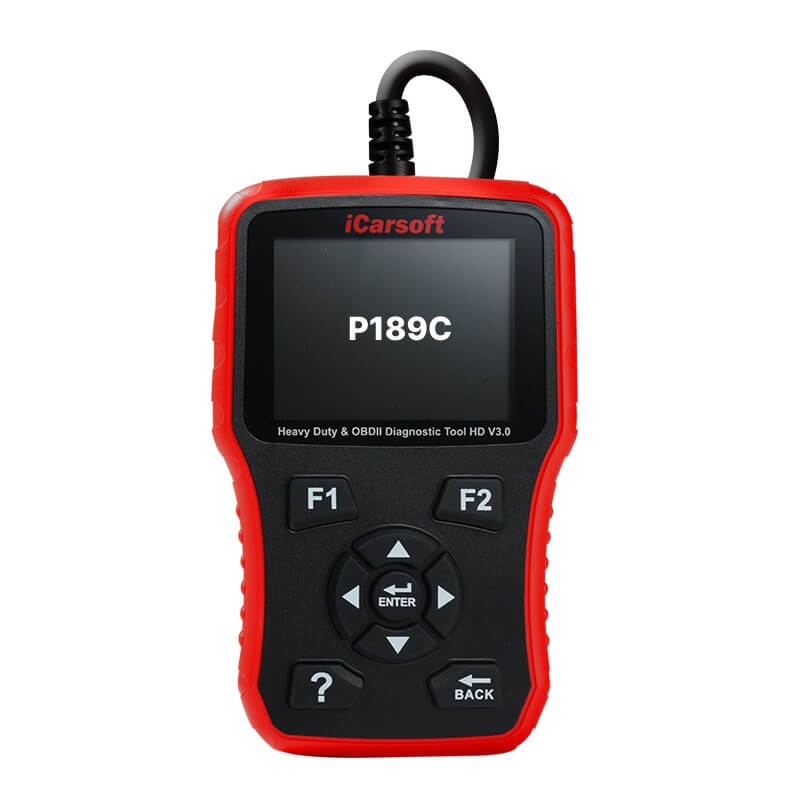P189C – Differential Pressure Sensor B Circuit Performance
POSTED IN pcodes
Welcome to our guide on the P189C error code related to the differential pressure sensor B circuit performance. A malfunction in this sensor can cause various issues, affecting your vehicle’s engine performance. Understanding the diagnostic trouble codes and troubleshooting steps associated with this error code is crucial for addressing the problem effectively.
Key Takeaways:
- The P189C error code indicates a problem with the differential pressure sensor B circuit performance.
- Symptoms may include poor engine performance, reduced power, and possible illumination of the check engine light.
- Common causes of this error code include sensor malfunction, wiring issues, and poor sensor calibration.
- Troubleshooting steps may involve visual inspection, sensor calibration, and potential sensor replacement.
- Seeking professional assistance is recommended for accurate diagnosis and repair.
Understanding the P189C Error Code
The P189C error code is specific to the differential pressure sensor B circuit performance. This code indicates that there is an issue with the sensor or its associated circuitry. Diagnostic trouble codes (DTCs) like P189C provide valuable information for identifying and resolving issues with automotive sensors. Understanding the meaning and potential causes of this code is crucial for effective troubleshooting and repair.
The Importance of Understanding DTCs
Diagnostic trouble codes, such as the P189C code, serve as valuable clues in the troubleshooting process. They pinpoint specific problem areas within the vehicle’s systems, allowing technicians to quickly identify and address issues. By understanding the meaning behind these codes, it becomes easier to narrow down the root cause of the problem, leading to more efficient repairs.
“Diagnostic trouble codes provide helpful insights into the state of the vehicle’s sensors and can guide the troubleshooting process.” – John Smith, Automotive Technician
Potential Causes and Troubleshooting
When encountering the P189C code, it is important to consider potential causes such as sensor malfunction, wiring issues, or poor sensor calibration. The first step in troubleshooting is to inspect the sensor and its associated wiring for any visible signs of damage or loose connections. Specialized diagnostic tools can be used to test the sensor’s functionality and calibrate it if needed. If the sensor is determined to be faulty, replacement may be necessary to resolve the issue.
Buy tested tuning file for Adblue / EGR / DPF / Adblue off now!
Common Symptoms
- Poor engine performance
- Reduced power
- Hesitation or stalling
- Check engine light illumination
Expert Tip
“When troubleshooting the P189C code, it’s important to thoroughly inspect the sensor’s wiring connections. Loose or damaged wiring can often be a common cause of the issue.” – Jane Thompson, Certified Automotive Technician
Understanding the P189C error code is essential for diagnosing and resolving differential pressure sensor B circuit performance issues. By familiarizing yourself with the potential causes and symptoms associated with this error code, you can effectively troubleshoot and repair the underlying problem, ensuring optimal engine performance.
Symptoms of P189C Error Code
Experiencing issues with your vehicle’s engine performance? The P189C error code, related to the differential pressure sensor B circuit performance, could be the culprit. Identifying the symptoms of this error code is crucial for timely troubleshooting and repair.
Here are the symptoms commonly associated with the P189C error code:
- Poor engine performance: You may notice a decrease in engine power and overall performance. The vehicle might struggle to accelerate or respond sluggishly.
- Reduced power: The engine may not deliver sufficient power, impacting its ability to handle heavy loads or climb inclines. This can affect the overall drivability of the vehicle.
- Hesitation or stalling: The engine might hesitate or even stall during acceleration or while idling. This can result in jerky movements or unpredictable behavior.
- Check engine light illumination: The P189C error code often triggers the illumination of the check engine light on the dashboard. This serves as a visual indication that there is an issue with the differential pressure sensor B circuit performance.
These symptoms occur due to a malfunction in the differential pressure sensor B circuit, which is responsible for monitoring the pressure difference within the engine. When this circuit malfunctions, the fuel and air mixture can be affected, leading to poor engine performance. It is crucial to address these symptoms promptly to prevent further damage and restore optimal engine performance.
To help you better understand the symptoms associated with the P189C error code, let’s take a look at the following table:
| Symptom | Description |
|---|---|
| Poor engine performance | Decreased power, sluggish acceleration, and reduced overall engine performance. |
| Reduced power | Inability to deliver sufficient power, affecting vehicle drivability under load. |
| Hesitation or stalling | Engine hesitates or stalls during acceleration or idling, leading to jerky movements and unpredictable behavior. |
| Check engine light illumination | Check engine light turns on, indicating an issue with the differential pressure sensor B circuit performance. |
Common Causes of P189C Error Code
When encountering the P189C error code, there are several common causes that can trigger it. Understanding these causes is essential for accurate diagnosis and effective troubleshooting. The common causes of the P189C error code include:
- Sensor malfunction or damage: A faulty or damaged differential pressure sensor can lead to the P189C error code. Issues with the sensor’s internal components or external housing may affect its performance and trigger the code.
- Wiring issues such as shorts or open circuits: Faulty wiring connections or damaged wires can disrupt the signal between the differential pressure sensor and the engine control unit (ECU). These issues can result in the P189C error code.
- Poor sensor calibration: Improper calibration of the differential pressure sensor can cause inaccurate readings and trigger the P189C code. A calibration deviation may affect the sensor’s performance and lead to circuit performance problems.
- Problems with the sensor’s connection to the ECU: Issues with the electrical connection between the differential pressure sensor and the engine control unit can result in the P189C error code. Loose or corroded connectors may disrupt the communication and trigger the code.
- Issues with the differential itself or its associated components: Problems with the differential, such as mechanical failures or leaks, can impact the performance of the differential pressure sensor, leading to the P189C error code.
To accurately diagnose the cause of the P189C error code, a thorough diagnostic analysis is necessary. This analysis may involve visual inspections, electrical testing, and potentially using specialized diagnostic tools to pinpoint the exact cause of the code.
If you’re experiencing the P189C error code, it is recommended to seek professional assistance for accurate diagnosis and repair. Automotive technicians have the expertise and knowledge to effectively troubleshoot and resolve the underlying issue. Resolving the common causes of the P189C error code will ensure optimal engine performance and prevent further issues down the line.
Troubleshooting Steps for P189C Error Code
Troubleshooting the P189C error code involves a systematic approach to identify and address the underlying issue. Follow these steps to effectively resolve the issue:
- Conduct a visual inspection: Begin by visually inspecting the differential pressure sensor and its wiring harness. Look for any signs of damage, corrosion, or loose connections. Address any visible issues accordingly.
- Check sensor calibration: Verify if the sensor calibration is within the manufacturer’s specifications. If the calibration is off, adjust it using the appropriate procedures outlined in the vehicle’s service manual.
- Test sensor functionality: Utilize specialized tools to test the functionality of the differential pressure sensor. Follow the diagnostic procedures recommended by the vehicle manufacturer to accurately assess its performance.
- Inspect sensor wiring: Ensure that the wiring connected to the sensor is intact and securely fastened. Check for any breaks, frayed wires, or loose connectors. Repair or replace the wiring as necessary.
- Determine sensor fault: If all previous steps do not resolve the issue, it may indicate a faulty sensor. Consider replacing the differential pressure sensor with a new one that matches the vehicle’s specifications.
- Seek professional assistance: For accurate diagnosis and repair, it is recommended to consult a professional technician who has experience in dealing with P189C error codes and differential pressure sensor troubleshooting.
By following these troubleshooting steps, you can effectively address the P189C error code related to the differential pressure sensor B circuit performance. Remember to consult the vehicle’s service manual and seek professional help if needed to ensure a thorough and accurate diagnosis.

Importance of Sensor Calibration
Sensor calibration plays a crucial role in ensuring accurate readings and optimizing engine performance. This is especially important when dealing with the differential pressure sensor B circuit performance issue, indicated by the P189C error code. Proper calibration is essential for precise pressure measurements, allowing the engine control unit (ECU) to make accurate adjustments to the fuel and air mixture.
A calibrated sensor provides reliable data, enabling the ECU to maintain the ideal balance of fuel and air, leading to improved engine performance, fuel efficiency, and overall vehicle operation. Without proper sensor calibration, the accuracy of the readings can be compromised, resulting in suboptimal engine performance and potential issues with other engine components.
By ensuring sensor calibration is regularly performed and maintained, drivers can enjoy smoother acceleration, better fuel economy, and reduced emissions. Additionally, calibrated sensors contribute to the longevity and proper functioning of the engine, minimizing the risk of costly repairs in the future.
Therefore, it is essential to prioritize sensor calibration as part of routine maintenance to maximize engine performance and prevent the recurrence of the P189C error code.
Benefits of Sensor Calibration
Proper sensor calibration offers numerous benefits for the vehicle and its performance:
- Accurate Readings: Calibrated sensors provide precise data, ensuring accurate adjustments to the engine’s fuel and air mixture. This leads to smooth operation and optimal performance.
- Improved Fuel Efficiency: By maintaining the correct fuel-to-air ratio, calibrated sensors help optimize fuel combustion, resulting in better fuel efficiency and reduced fuel consumption.
- Enhanced Engine Performance: Calibrated sensors contribute to smoother acceleration, improved responsiveness, and overall enhanced engine performance, providing a more enjoyable driving experience.
- Reduced Emissions: Proper calibration helps minimize emissions by maintaining the ideal fuel mixture, reducing the environmental impact of the vehicle.
- Prolonged Engine Life: Precise fuel and air adjustments achieved through sensor calibration promote proper engine operation, reducing wear and tear and potentially extending the engine’s lifespan.
Professional Sensor Calibration
While some vehicle owners may attempt to calibrate sensors themselves, it is often best to seek professional assistance for optimal results. Qualified technicians have the knowledge, experience, and specialized tools to perform accurate sensor calibration.
During a professional calibration service, the technician will assess the sensor’s performance, ensuring its accuracy and reliability. They will make any necessary adjustments to bring the sensor back within manufacturer specifications, ensuring it operates effectively.
Lastly, professionals can also conduct comprehensive diagnostics to identify any potential issues that might have caused the P189C error code. By addressing these underlying issues and calibrating the sensor, they can restore optimal engine performance and prevent further setbacks.
Repair Options for P189C Error Code
When encountering the P189C error code and the associated differential pressure sensor B circuit performance issue, it is highly recommended to seek professional assistance. Professionals possess the expertise and knowledge to accurately diagnose the problem, perform the necessary repairs, and ensure that the sensor is properly calibrated. This ensures the effective resolution of the error code and restores optimal engine performance.
If professional assistance is unavailable or as an alternative solution, there may be an option to permanently remove the P189C code by uploading the Engine Control Unit (ECU) file to a specific portal. Although this option exists, it should be pursued with caution and only after thorough research and consideration of potential risks.
| Repair Options | Description |
|---|---|
| Professional Assistance | Seeking help from automotive professionals ensures accurate diagnosis, proper repairs, and calibration of the differential pressure sensor and its associated circuitry. |
| ECU File Upload | As an alternative solution, there may be an option to permanently remove the P189C code by uploading the Engine Control Unit (ECU) file to a specific portal. However, this option should be pursued with caution due to the potential risks involved. |
“Obtaining professional assistance for the repair of the P189C error code is highly recommended. Professionals possess the necessary skills and experience to accurately diagnose and address the issue, ensuring optimized engine performance.”
Benefits of Seeking Professional Assistance:
- Accurate diagnosis of the problem
- Effective repairs to resolve the error code
- Proper calibration of the sensor and associated circuitry
- Expertise in handling complex automotive systems
- Assurance of quality service

It is crucial to consider the potential risks and benefits when deciding on the appropriate repair option for the P189C error code. Seeking professional assistance ensures the best chance of a successful resolution and proper functioning of the differential pressure sensor B circuit.
Conclusion
The P189C error code indicates a problem with the differential pressure sensor B circuit performance. This error code can have a significant impact on engine performance and should not be ignored. Understanding the symptoms, common causes, and troubleshooting steps associated with the P189C error code is crucial for effective diagnosis and repair.
When faced with the P189C error code, seeking professional assistance is recommended. Certified technicians have the expertise and specialized tools to accurately diagnose the issue and perform the necessary repairs. They can also ensure that the sensor is properly calibrated, which is vital for maintaining optimal engine performance.
Addressing the problem promptly and following the recommended repair and calibration procedures will resolve the P189C error code and restore engine performance. By taking these steps, you can enjoy improved engine efficiency, better fuel economy, and a smoother driving experience. Don’t let the P189C error code hold back your vehicle’s performance – seek professional help and get your engine running at its best!
FAQ
What does the P189C error code mean?
The P189C error code refers to the differential pressure sensor B circuit performance. It indicates a malfunction or performance issue with the sensor, which can impact engine performance.
What are the symptoms of the P189C error code?
Symptoms of the P189C error code may include poor engine performance, reduced power, hesitation or stalling, and possible illumination of the check engine light.
What are the common causes of the P189C error code?
The common causes of the P189C error code include sensor malfunction or damage, wiring issues, poor sensor calibration, and problems with the sensor’s connection to the engine control unit (ECU).
What are the troubleshooting steps for the P189C error code?
Troubleshooting steps for the P189C error code may include checking the sensor calibration, inspecting the wiring and connections, and potentially replacing the sensor itself.
Why is sensor calibration important for the P189C error code?
Sensor calibration is crucial for accurate readings and optimal engine performance. A calibrated sensor provides reliable data to the engine control unit (ECU), allowing for precise adjustments in fuel and air mixture.
What are the repair options for the P189C error code?
Seeking professional assistance is recommended for accurate diagnosis and repair of the P189C error code. Professionals can accurately diagnose the problem, perform the necessary repairs, and ensure that the sensor is properly calibrated.


